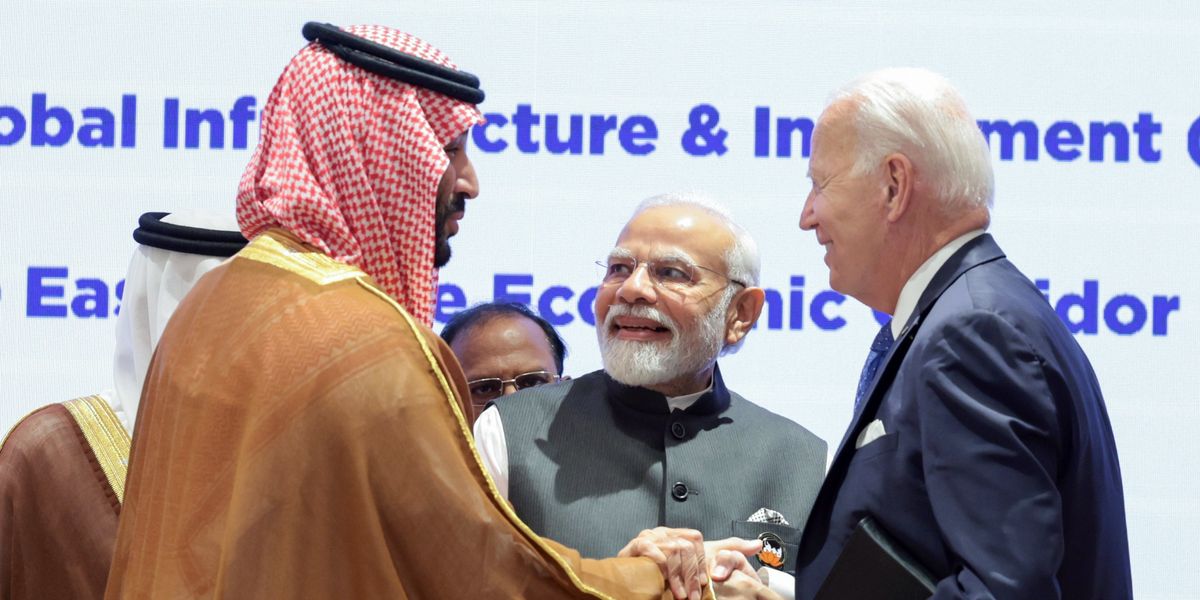Ten years after Chinese President Xi Jinping announced China’s Belt and Road Initiative (BRI) in Kazakhstan and Indonesia, a new connectivity initiative was unveiled with great fanfare by the United States, India, and the Arab Gulf and European countries during the G20 meeting in New Delhi earlier this month.
Since the announcement was made without the presence of the Russian and Chinese presidents, it has stirred conflicting interpretations. Some see it as a potential alternative to BRI, while others, pointing to the failure of similar projects backed by Western powers in the past, view it as a paper tiger.
Details are still missing, but the project’s ambition is enormous. It follows a transregional approach as noted by the White House statement: “Through the India-Middle East-Europe Economic Corridor (IMEC), we aim to usher in a new era of connectivity with a railway, linked through ports connecting Europe, the Middle East, and Asia.”
The idea of this corridor dates back to 2021 and has also been discussed as part of the I2U2 group that includes India, Israel, the United Arab Emirates (UAE) and the United States. Like the BRI, its design vision follows the corridor's logic. This is no surprise. “Corridorization” is the most significant spatial manifestation of infrastructural capitalism and geo-economics since the beginning of this century.
Corridorization, which is part of the thriving “minilateralism” space, could be viewed as contradictory because middle powers are trying to navigate between two hardening geopolitical blocs. But the ongoing process of reshaping the global supply chain connectivities created by decades of globalization could make it a viable proposition.
The BRI and the IMEC seem to share many similar goals. But there are also critical geographical differences. Most importantly, the new initiative features India, which has never been part of the BRI, as a central cross-regional player amid rearranged geo-imaginations.
Each of the parties to the new initiative comes with its own perspective and interest.
For the United States, the I2U2 and IMEC serve as platforms for infrastructure investment, bringing together Middle Eastern and South Asian partners and providing an alternative to Chinese projects. Washington sees this approach as an opportunity to encourage its regional partners to take a more active and independent role in shaping the region’s future, allowing the United States to reduce its own resource investment while maintaining its presence and influence.
For the UAE and Saudi Arabia, the goal is to strengthen their increasingly diversified and multi-networked economic diplomacy covering a wider geography. Both countries are active members of the BRI, and their cooperation with China is growing. Apart from burgeoning trade, they are dialogue partners of the Shanghai Cooperation Organization (SCO) and will soon become full members of the expanded BRICS (Brazil, Russia, India, China, and South Africa). Both countries are trying to expand their strategic autonomy and vying to become influential regional and international players. Getting involved in multiple new minilateral groupings is a key ingredient of their approach to strengthening their middle power status.
As Saudi Arabia opens to the world with a tilt towards China, the UAE has found its new unique selling point in connectivity and multi-alignment. While diverging approaches toward geostrategic and regional issues, particularly China’s rising power and global influence, remain a concern, Gulf Arab countries’ participation in U.S.-led initiatives reflects their new penchant for equidistance amid U.S.-China competition.
Indeed, the United States might see the IMEC as a vehicle to counter China’s growing influence in the region. In the Middle East, however, competition and convergence are mixed and less black and white than the increasing U.S.-China bipolarity would suggest. If the United States expects this to be a “counter BRI” move for the region, it will likely be disappointed. Competition in the Indian Ocean could escalate, but potential synergies and convergencies should allow for some degree of mutual accommodation.
India, which the United States treats as an “indispensable partner,” has been showcasing a good template of multi-alignment for others to follow. It is a member of the Quad and I2U2, both comprising the United States, and it’s also a member of BRICS and SCO, with China in both, despite New Delhi’s feud with Beijing over border issues. The IMEC adds another thread to its longstanding multi-alignment policy, as it highlights the other connectivity corridor that India is promoting — the International North South Transport Corridor — with Iran and Russia. Together, these projects add value to India’s development story and its boast that it is the fastest growing economy in the world.
The new economic corridor also envisions the potential addition of Israel. This should be seen as a step in the renewed U.S. efforts to expand the Abraham Accords by facilitating the normalization of Israeli-Saudi relations. This form of regional engagement also allows Israel to manage tensions with the United States, the UAE, and Saudi Arabia in the wake of the politics of a far-right coalition led by Prime Minister Benjamin Netanyahu.
For Israel and the United States, expanding the Abraham Accords, especially to include Saudi Arabia, remains a top priority despite Riyadh’s insistence on linking the normalization of relations to progress on the two-state solution. There are tentative indications that Netanyahu might agree to some concessions on the Palestinian front, even at the cost of his right-wing coalition falling apart, in order to capitalize and sustain Israel’s broader regional integration.
For China, which will soon host the first in-person BRI summit in Beijing after major COVID-19 shutdowns, IMEC throws up a challenge and an opportunity. It could dismissively treat the IMEC like the United States has done with the BRI. The other option, as indicated soon after the G20 meeting, is to demonstrate its openness to support multidirectional connectivity, even if it is not part of this corridor, as long as such projects are “open, inclusive, and form synergy,” and do not become “geopolitical tools.”
The last piece in this new connectivity saga would be Europe, especially the Eastern Mediterranean countries. The IMEC is a welcome development because the “Global Gateway,” the European Union’s own connectivity project, has not gained adequate momentum because European diplomats in Brussels are hesitant about multi-alignment strategies and transregional corridors.
While the IMEC is an economic-diplomatic-security interplay, its prospects will depend on its ability to promote connectivity and translate its economic potential into commercial success. Critics have already pointed out that the initiative may be unviable in terms of profit. However, it could also be argued that there are virtues other than economic efficiency. In a world of de-risking and politically induced supply chain shifts, the new corridor could be viewed as a tool for promoting strategic resilience, friendshoring, and tech cooperation, especially for middle powers.
- The Middle East braces for fallout of US–China divide ›
- The United States, China, and great power competition in the Middle East ›















